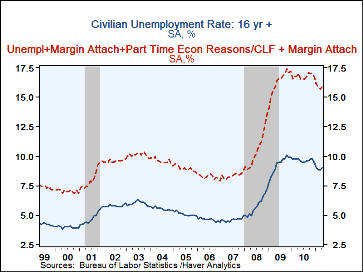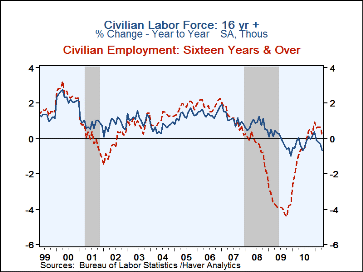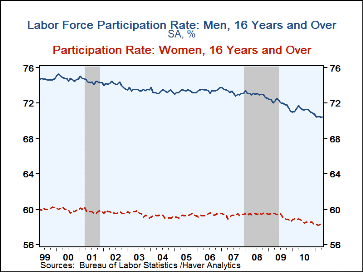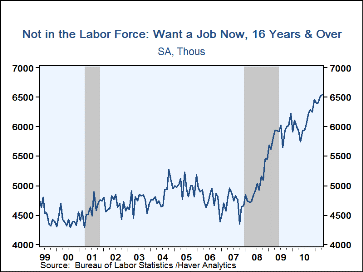 Global| May 18 2011
Global| May 18 2011U.S.-- The Jobless Rate Is High And Labor Force Participation Is Low
by:Tom Moeller
|in:Economy in Brief
Summary
The current unemployment rate of 9.0% is down from its October, 2009 peak of 10.1%. The decline occurred due to negligible 0.9% growth in employment during that period. The economic recovery has been slow. Further impetus for the [...]
The current unemployment rate of 9.0% is down from its October, 2009 peak of 10.1%. The decline occurred due to negligible 0.9% growth in employment during that period. The economic recovery has been slow. Further impetus for the decline, however, was the 0.4% decline in the labor force. Individuals are just not looking for work like they had been. In fact, that downward bias has been in place for some time. The implication for economic growth is that consumers are not in a position to spend freely.
In 2011, the U.S. population aged 16 years or over equaled 238.9M. That total was accompanied by a low 64.2% workforce participation rate. This participation rate is down from the peak ten years ago of 67.0%. Had the decline not occurred, the unemployment rate could be 2-to-3 percentage points higher than it currently is.
Several forces have been in play, causing labor force participation to decline -- some cyclical, some structural. The cyclical factors are related to the weak economic recovery. Workers have become discouraged by their inability to find employment. Six and one-half million individuals are not in the labor force but want a job now. That compares to 4.5 million persons during the 2000 low. The structural factors lowering labor force participation are many. The aging of the baby boom generation has pulled some workers into retirement. Second, the earlier rise in adult woman's' labor force participation rate has topped out. Finally, young adults are staying in college longer. Partially offsetting these influences is the delaying of retirement by older individuals due to better health and longer life spans.
The bottom line is that the recent, small decline in the unemployment rate indicates some healing of the labor market. However, the rate of improvement has been quite slow for reasons that will not go away quickly, even if job growth picks up. Therefore the unemployment rate is likely to remain elevated for some time. Moreover, the unemployment rate including marginally attached and persons working part-time for economic reasons currently is 16%. The analysis above indicates it may be closer to 20%. In this environment, counting on robust consumer spending to fuel the economic recovery seems implausible.
The employment data are contained in Haver's USECON database.
| U.S. Labor Force | 2011 'YTD | 2006 | 2001 | 1991 | 1981 |
|---|---|---|---|---|---|
| Participation Rate | 64.2% | 66.2% | 66.8% | 66.2% | 63.9% |
| Labor Force (Million) | 123.3 | 151.4 | 143.8 | 126.4 | 108.7 |
| Population (Million) | 238.9 | 228.8 | 215.1 | 190.9 | 170.1 |
Tom Moeller
AuthorMore in Author Profile »Prior to joining Haver Analytics in 2000, Mr. Moeller worked as the Economist at Chancellor Capital Management from 1985 to 1999. There, he developed comprehensive economic forecasts and interpreted economic data for equity and fixed income portfolio managers. Also at Chancellor, Mr. Moeller worked as an equity analyst and was responsible for researching and rating companies in the economically sensitive automobile and housing industries for investment in Chancellor’s equity portfolio. Prior to joining Chancellor, Mr. Moeller was an Economist at Citibank from 1979 to 1984. He also analyzed pricing behavior in the metals industry for the Council on Wage and Price Stability in Washington, D.C. In 1999, Mr. Moeller received the award for most accurate forecast from the Forecasters' Club of New York. From 1990 to 1992 he was President of the New York Association for Business Economists. Mr. Moeller earned an M.B.A. in Finance from Fordham University, where he graduated in 1987. He holds a Bachelor of Arts in Economics from George Washington University.










